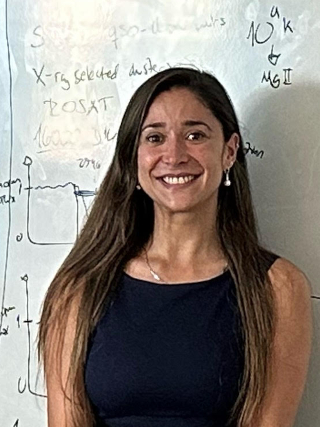Alejandra Yrupe Fresco: On the search for the missing baryons
Thursday, 09 May 2024 2 p.m. — 3 p.m. MST
Your time:

Gemini North Hilo Base Facility | 670 N A’ohoku Place Hilo, Hawaii, 96720, USA
Today, the majority of the baryons in the Universe are not observed directly, leading to the so-called "missing baryons" problem at low redshift. Cosmological hydrodynamical simulations predict that these missing baryons can be "hidden" in the Warm-Hot Intergalactic Medium (WHIM), i.e., in gas in the cosmic web with temperatures as high as 105–107K. While the cooler phase of this gas has been routinely detected using O VI and Ne VIII absorbers at UV wavelengths, the hotter fraction detection relies mostly on observations of O VII and O VIII at X-ray wavelengths. I will present a novel approach to directly probe the hot gas components by targeting the forbidden line [Fe XXI] λ1354Å which traces 107K gas at UV wavelengths. By combining more than one hundred high-spectral resolution (R∼49,000) and high signal to noise VLT/UVES quasar spectra (corresponding to over 600 hrs of VLT time observations) this approach set the first limit on the [Fe XXI] absorption strength and showcases how the next generation of 30m telescopes will be able to directly detect the elusive WHIM in absorption from the ground.
In the second part of the talk, I will show how stacking can be utilized to constrain another elusive baryon status, i.e., cold gas inside massive galaxy clusters, where X-rays observations have shown that 70% of the intracluster medium is made out of gas in the hot phase but cosmological simulations predict the presence of a cold gas component that is not directly observable in emission. I will show the results of cross matching X-ray-selected massive (mean mass ~2.7×1014M⊙) galaxy clusters with spectroscopic redshift from the SDSS/SPIDERS survey with 20,000 background quasar optical spectra from SDSS DR16. This resulted in the detection of MgII in absorption, revealing the diffuse T=104K gas component of the intracluster medium with an average column density N(MgII) = 1012.12 cm−2, which is below current expectations from cosmological simulations.
I will conclude the presentation by summarizing the current work done in our group at the University of Milano-Bicocca to probe the properties of baryon in and around galaxies.
For Zoom connection information, please contact Emanuele Paolo Farina (emanuele.farina_at_noirlab.edu).
Back to Gemini north talks.